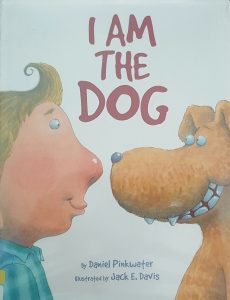

Title: I am the Dog
Author: Daniel Pinkwater
Illustrator: Jack E. Davis
Publishers and Year: Harper Collins Publisher, 2010
Number of pages: 30
Genre: Fiction
This book tells the story of a boy who switches places with his dog for the day. It goes through the day’s events with the roles reversed, and the readers enter the mind of the dog through the boy. The story culminates with the conclusion that being a dog is better than being a boy.
I believe that this book is being used as a window. Many children have pets in their homes or know someone who does. By Jacob pretending to be a dog for a day, the readers get an up close and personal look into the mind of a dog. While reading the book I found myself thinking like (the readers assume) a dog would think and focusing on things a dog would focus on. Since children do not always put themselves in someone else’s shoes easily, this book provides an excellent window into the mind of their pet. They are able to realize the things that are important and possibly build more compassion towards them. Not only does this give them a window into the mind of a dog, but it opens them up to being able to step into the perspectives of the people around them as well.
In this book, power is distributed evenly. I noticed from the first time reading it that the illustrator drew the boy and his dog to be equal in size. Throughout the entire book they stay this same size. This shows me the equality between the two. They are switching places but the power never shifts. They remain equally important throughout the book. This speaks of the importance of having as much value for someone else’s’ perspective as your own.
As far as cultures go, there is only one culture represented: white middle class. There is no diversity in the characters throughout the book. Even during the scene at the boy’s elementary school, every single child is white.
The visuals in this text help bridge the gap between the new mindset the readers are being introduced to and the common actions of dogs that the readers see on a daily basis. For example, the readers see the dog excited for food. The readers have all seen that at one point of another. However, seeing that while hearing the intense emotion of excitement from the dog’s perspective gives opportunity for children to connect the new information-to-information they already have. There is not much to be gained through the structure of the text, however. The text is not formatted in any particular way that brings special meaning to the story. However, the text itself does a fantastic job of incorporating sounds and stream of consciousness that a dog might have which helps the message come across in a very clear way. Overall, this book reminds us that it is important for people to view others with as much value as they would view themselves and to be able to view situations through the lens of another.
